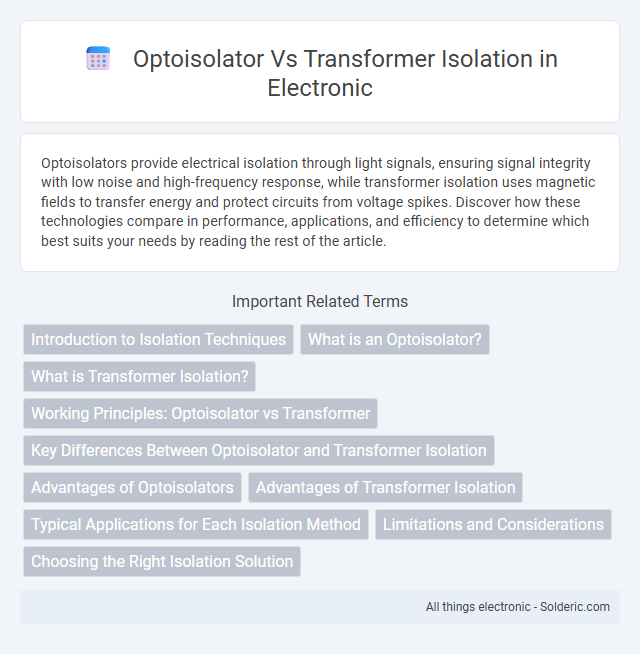Optoisolators provide electrical isolation through light signals, ensuring signal integrity with low noise and high-frequency response, while transformer isolation uses magnetic fields to transfer energy and protect circuits from voltage spikes. Discover how these technologies compare in performance, applications, and efficiency to determine which best suits your needs by reading the rest of the article.
Comparison Table
| Feature | Optoisolator Isolation | Transformer Isolation |
|---|---|---|
| Isolation Method | Optical coupling using LED and photodetector | Magnetic coupling via coils and core |
| Isolation Voltage | Up to 5 kV (depending on model) | Up to several kV, often higher than optoisolators |
| Signal Type | Digital or low-frequency analog signals | AC signals, pulses, wide frequency range |
| Bandwidth | Typically up to a few MHz | Up to several MHz or higher |
| Size | Compact, integrated device | Larger due to coils and magnetic core |
| Power Consumption | Low input current, no external power | Requires power for transformer winding |
| Output Type | Electrical signal, needs amplification for analog | Same electrical signal with voltage transformation |
| Cost | Low to moderate cost | Moderate to high cost depending on size and ratings |
| Applications | Digital signal isolation, microcontroller interfaces, communication | Power supply isolation, signal isolation in power electronics |
Introduction to Isolation Techniques
Optoisolator isolation uses light to transfer signals between circuits, providing electrical separation and reducing noise interference in sensitive applications. Transformer isolation employs magnetic coupling to transmit energy while isolating input and output, often used in power supplies and signal conditioning. Your choice depends on factors like signal type, frequency, and required isolation voltage.
What is an Optoisolator?
An optoisolator is a semiconductor device that transfers electrical signals between two isolated circuits using light, providing electrical isolation and protecting your system from high voltages or noise. Unlike transformer isolation, which relies on magnetic coupling, an optoisolator uses an LED and photodetector pair to ensure signal integrity across isolated barriers. This technology is essential in applications requiring precise signal isolation, such as microcontroller interfaces and communication systems.
What is Transformer Isolation?
Transformer isolation is an electrical isolation method using magnetic coupling between primary and secondary windings to transfer energy while preventing direct electrical connection. It provides voltage level shifting, noise reduction, and safety by isolating circuits and breaking ground loops. Widely used in power supplies and signal transmission, transformer isolation enhances system reliability and protects sensitive components from voltage spikes.
Working Principles: Optoisolator vs Transformer
Optoisolators transmit electrical signals using light through an LED and photodetector pair, providing galvanic isolation by converting electrical input into optical signals and back, which ensures low noise and high-speed communication. Transformers operate on electromagnetic induction, transferring energy between coils through a magnetic field to achieve isolation and voltage transformation without direct electrical connection. Your choice between these depends on factors like signal type, frequency, size constraints, and isolation requirements.
Key Differences Between Optoisolator and Transformer Isolation
Optoisolators provide electrical isolation using light signals to transfer data between circuits, ensuring high-speed digital signal transmission with minimal interference. Transformer isolation relies on electromagnetic induction to isolate and transfer analog or power signals, typically used for voltage level shifting and AC signal isolation. Key differences include bandwidth capacity, signal type compatibility, size, and power consumption, with optoisolators excelling in compact, low-power digital communication and transformers suited for robust power isolation and signal integrity in AC applications.
Advantages of Optoisolators
Optoisolators provide high electrical isolation with minimal signal distortion, making them ideal for precise data communication between circuits operating at different voltage levels. They offer compact size, low power consumption, and immunity to electromagnetic interference, ensuring reliable performance in sensitive electronic applications. Your system benefits from enhanced safety and noise reduction compared to transformer isolation, especially in low-frequency or DC signal transmission.
Advantages of Transformer Isolation
Transformer isolation provides galvanic separation and can handle high voltage transients while maintaining signal integrity. It supports bidirectional power transfer and offers excellent noise immunity in industrial and medical applications. Unlike optoisolators, transformers have no wear-out mechanisms related to semiconductor aging, leading to greater reliability in long-term use.
Typical Applications for Each Isolation Method
Optoisolators are widely used in digital communication interfaces, microcontroller signal isolation, and noise-sensitive sensor circuits due to their ability to provide electrical separation with high-speed signal transmission. Transformer isolation finds typical applications in power supply circuits, audio systems, and high-voltage measurement where galvanic isolation and voltage level shifting are critical. Choosing the appropriate isolation method for your system depends on factors like signal type, frequency, voltage levels, and the desired level of electrical isolation.
Limitations and Considerations
Optoisolators face limitations such as lower bandwidth and potential signal distortion due to LED and photodetector response times, making them less suitable for high-frequency applications. Transformer isolation provides excellent high-frequency signal integrity and galvanic isolation but is limited by size, weight, and susceptibility to electromagnetic interference (EMI). Designers must consider factors like isolation voltage ratings, signal fidelity, power consumption, and application-specific requirements when choosing between optoisolators and transformers.
Choosing the Right Isolation Solution
Choosing the right isolation solution depends on your application's voltage levels, signal type, and response speed requirements. Optoisolators excel in low-voltage, signal-level isolation with fast response times, ideal for digital communication and microcontroller interfaces. Transformers provide robust isolation for AC power and high-voltage applications, offering galvanic separation and the ability to handle higher power loads safely.
optoisolator vs transformer isolation Infographic

 solderic.com
solderic.com